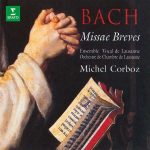
Composer: Johann Sebastian Bach
Performer: Wolfgang Rübsam
Format: FLAC (tracks)
Label: Brilliant Classics
Catalogue: 96464
Release: 2022
Size: 812 MB
Recovery: +3%
Scan: yes
Playwright Luise Gottsched, née Kulmus, in 1732 wrote a letter to her future husband, the writer Johann Christoph Gottsched: “The keyboard pieces sent over by Bach… are as difficult as they are beautiful. Even after playing them ten times, they still seem new to me”. A few years later polymath and Bach’s former pupil Lorenz Christoph Mizler offered the following advice regarding this Clavier-Übung I: “Anyone who has difficulties with keyboard fingering will find it difficult to learn the keyboard pieces written by the famous Mr. Bach in Leipzig”.
Clavier-Übung I contains six suites, called “Partitas”, in which stylized dances are preceded by different kinds of introductory movements, variously entitled Praeludium, Praeambulum, Sinfonia, Fantasia, Overture, and Toccata, all forms and types of late Baroque keyboard music. This third collection of keyboard suites (BWV 825-830) occupies a special place in Bach’s (1685-1750) entire oeuvre, because it was the first work that he was to engrave and publish himself in the period 1726-1741. He entitled the series “Clavier-Übung”, and each separate suite Partita. Like the English Suites, the Partitas begin with an introductory piece which is of a different character in each partita – sometimes like an invention (Partita I), sometimes a French overture (Partita II and Partita IV), and sometimes a fantasy (Partita III). The pieces display French and Italian characteristics, but they also seem to anticipate the expressive melodic style of Carl Philipp Emanuel Bach. All Bach’s six Partitas have the dances of the classical suite – allemande, courante, sarabande, gigue – (except for the omission of the gigue from No. 2). But Bach went further in his addition of “ander Galanterien”, as he calls them on the title-page. Every partita has at least one. Clearly Bach intended to give each Partita its individual distinct character.
The name “Sinfonia” for the first movement in the Partita in C minor is redolent of opening cantata movements and the dotted rhythm of a French overture. The Grave adagio however, is not followed by the fugal fast section you would expect here. This approach was carried out more consistently and stylistically in the Partita in D major, although there the fast section approaches the form of a concerto. Instead, the Grave adagio of the Partita in C minor is followed by a sonata-like movement with an arabesque effect in the upper voice, followed by a lively fugato. As a result, the piece appears in three parts. In contrast, the opening Fantasia in the Partita in A minor is more akin to an invention, showing similarities with the opening section of the Second English Suite of the same key. Moreover, since the 17th century, the distinction between the terms “Praeludium” and Praeambulum was insignificant. Yet Bach’s delicately sculpted Praeludium in the B-flat major Partita, is stylistically very different from the concerto-like Praeambulum of the Partita in G major. Lastly, the Toccata in the Partita in E minor offers rhapsodic-improvisatory sections framing a fugue after the style of Froberger, whose works for keyboard instruments must have been known to Bach.
The original dance movement went through a functional transformation to become a character work of sorts; in this way, Bach made one of the first contributions to this later extremely popular style of keyboard music.
Wolfgang Rübsam contrived to record all the Partitas on the lute- harpsichord. This was inspired by an estate inventory of 1750, which shows Bach owned at least two lute-harpsichords. The suggestion proved to be especially fortunate and is still a rarity among today’s publications. For the Partita movements written in the “style luthé”, such as the Allemande of the Partita in B-flat major, the lute-harpsichord is perfect. The poetic tone of the creation from Keith Hill’s studio, sonorous and noble in the lower registers and brilliant in the higher registers, enters into an almost perfect synthesis with Rübsam’s rhetorically sensitive playing, which is characterised by great ornamental and improvisational ingenuity. The selected temperament of Vallotti, with its tuning system approaching pure thirds, does the rest.



